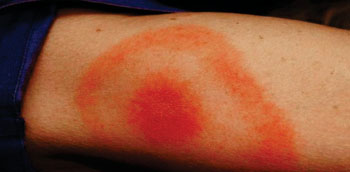Early-Detection Urine Test Is Effective for Lyme Disease
By LabMedica International staff writers
Posted on 01 Jun 2016
Prompt antibiotic treatment of early stage Lyme Borreliosis (LB) prevents progression to severe multisystem disease and there is a clinical need to improve the diagnostic specificity of early stage Lyme assays in the period prior to the mounting of a robust serology response.Posted on 01 Jun 2016
The clinical presentation of LB can be so varied; early stage disease can be misdiagnosed for a variety of reasons including failure to develop an erythema migrans (EM) rash, failure of the patient or clinician to recognize an EM rash, if present, the non-specific nature of early symptoms and a negative or ambiguous serology.

Image: The typical erythema migrans or bulls-eye rash often but not always seen in Lyme disease (Photo courtesy of the CDC).
Scientists at the George Mason University (Fairfax, VA, USA) obtained mid-stream urine specimens that were self-collected by 268 participants with all stages of documented or suspected Lyme disease. Whole blood from each subject was drawn on the same day as urine collection. Blood samples were sent to Quest Diagnostics (Madison, NJ, USA) for Total Lyme Disease Antibody (EIA) and Lyme immunoglobulin G (IgG) and IgM Western Blot tests.
The scientists employed Nanotrap particles (Ceres Nanosciences, Manassas, VA, USA) to concentrate urinary OspA and used a highly specific anti-OspA monoclonal antibody (mAb) as a detector of the C-terminus peptides. They mapped the mAb epitope to a narrow specific OspA C-terminal domain OspA236-239 conserved across infectious Borrelia species but with no homology to human proteins and no cross-reactivity with relevant viral and non-Borrelia bacterial proteins. They collected 268 urine samples from patients being evaluated for all categories of LB in a LB endemic area. The urinary OspA assay, blinded to outcome, utilized Nanotrap particle pre-processing, western blotting to evaluate the OspA molecular size, and OspA peptide competition for confirmation.
The team found that in pre-treatment, 24/24 newly diagnosed patients with an erythema migrans (EM) rash were positive for urinary OspA while false positives for asymptomatic patients were 0/117. For 10 patients who exhibited persistence of the EM rash during the course of antibiotic therapy, 10/10 were positive for urinary OspA. Urinary OspA of 8/8 patients switched from detectable to undetectable following symptom resolution post-treatment. Specificity of the urinary OspA test for the clinical symptoms was 40/40. Specificity of the urinary OspA antigen test for later serology outcome was 87.5 % (21 urinary OspA positive/24 serology positive, and 41 of 100 patients under surveillance for persistent LB in an endemic area were positive for urinary OspA protein.
Alessandra Luchini, PhD, a professor and lead investigator of the study, said, “We're looking to repeat the story again with these other diseases. Other targets for the new type of test include Chagas disease, which is infectious and caused by a parasite, and toxoplasmosis, another parasite-borne disease.” The study was published originally published online on November 4, 2015, in the Journal of Translational Medicine.
Related Links:
George Mason University
Quest Diagnostics
Ceres Nanosciences














